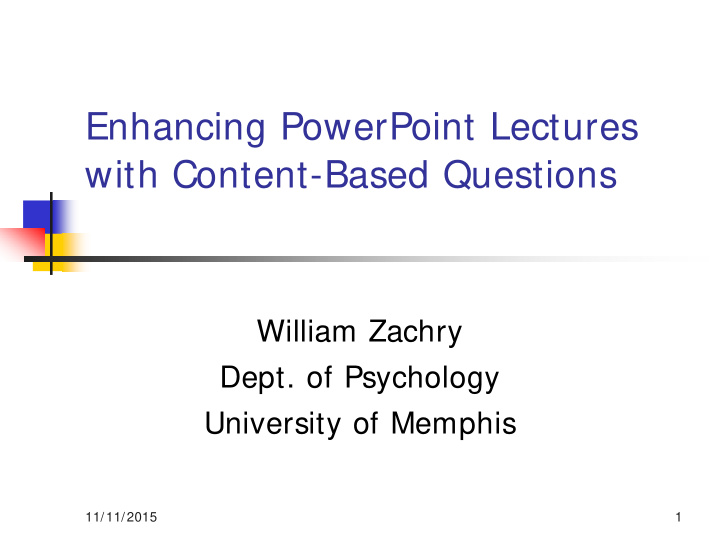



Enhancing PowerPoint Lectures with Content-Based Questions William Zachry Dept. of Psychology University of Memphis 11/11/2015 1
CBQ = Content Based Questions CBQ is a quick and easy method of promoting closer attention and better learning in the classroom It is backed by empirical studies Students find it useful It requires no grading It meshes well with the lecture method 11/11/2015 2
“Incorporating Active Learning With PowerPoint- Based Lectures Using Content-Based Questions” Gier & Kreiner (2009) described the CBQ technique in Teaching of Psychology and supported it with two classroom-based experiments. Experiment 1 Participants from two upper-division cognitive psychology courses at two midsized Midwestern universities Comparable gender and age distributions Classes both taught by same instructor 11/11/2015 3
Experiment 1 (continued) Experimental group received PowerPoint lectures and handouts plus three 10-question CBQ sets per 2.5 hr class. Control group received PowerPoint lectures and handouts plus 30-minute small-group discussions over the same material as the CBQ’s covered in the Experimental group. Experimental group improved more than Controls on pre-post quizzes in each class meeting and scored higher on hour-exam averages and on the final exam. 11/11/2015 4
Experiment 2 Within-subjects study in one History of Psychology course Course divided into “quarters” During 2 randomly-chosen “quarters” students received Power-Point lectures and slide handouts During the other 2 “quarters” there were 3 10-item CBQ’s presented each class 11/11/2015 5
Experiment 2 (continued) Students showed more improvement on pre-post quizzes in the CBQ “quarters” Students made higher scores on hour- exams during the CBQ “quarters” 11/11/2015 6
Additional Considerations Students had to write out the questions Students actively generated answers Students received immediate feedback Authors suggest instructor-provided PowerPoint slides should give only partial information, requiring active note-taking by students in class 11/11/2015 7
Informal Assessment of CBQ In U of M Social Psychology class 1. Comparison of quiz scores --See slide 9 2. Student opinion survey --See slide 10 11/11/2015 8
Spring 2009 – PowerPoints only Fall 2009 – PowerPoints plus CBQ Spring 2009 – Quiz 1 Fall 2009 – Quiz 1 Mean = 84.07 Mean = 88.39
Preliminary poll in Psyc 3106 Are CBQ’s useful in Yes 50 1. identifying what you know Unsure 2 or don’t know about the No 0 course material? Yes 38 Are CBQ’s useful in 2. Unsure 14 improving your learning of No 0 course material? Yes 45 Would you recommend 3. that CBQ’s continue to be Unsure 7 used in our class this No 0 semester? 11/11/2015 10
Reference Gier, Vicki S. and Kriener, David S. (2009) Incorporating Active Learning With PowerPoint-Based Lectures Using Content-Based Questions. Teaching of Psychology, 36:2, 134-139. Full text available with U of M login. Go to http://www.memphis.edu/psychology and follow this path: Library Resources/PsycInfo (full text is 11/11/2015 11 d d t b t t i P I f )
Sample CBQ’s from Social Psychology Class at Univ. of Memphis, Fall 2009 The following slides contain a sample of CBQ’s used in a Social Psychology class taught at the University of Memphis in fall 2009. 11/11/2015 12
CBQ # 1 Social psychology is: ________________________________ ________________________________ Explain Kurt Lewin’s formula B = f(P,E) 11/11/2015 13
CBQ 2 Three goals of psychology and the 1. research methods that are associated with each one are ______________. One strength of observational 2. research methods is _____________. Is a correlation of -.85 a strong or 3. weak correlation? _______________. Why? ________________________. 11/11/2015 11/11/2015 14 14
CBQ 3 The experimental method is best at 1. establishing ________________. The crucial aspect of the experimental 2. method is __________________. The factor manipulated by an 3. experimenter to see what will result is called a(n) _________________. 11/11/2015 11/11/2015 15 15
CBQ 4 Define the “self-reference effect”. Identify three factors that influence the development of the ”social self”. State one difference between an “individualistic” culture and a “collectivist” culture. 11/11/2015 16
CBQ 5 1. State one difference between an “independent self” and an “interdependent self”. 2. How do the “independent self” and the “interdependent self” match up with an “individualist culture” or a “collectivist culture”? 11/11/2015 17
CBQ 6 1. Define the “self-serving bias”. 2. Do you think there would be different degrees of self-serving bias in individualist vs. collectivist cultures? Why or why not? 11/11/2015 18
CBQ 7 1. Name and define two types of attribution in Heider’s theory. 2. What is the “fundamental attribution error”? Give an example (from real life experiences if possible). 11/11/2015 19
CBQ 8 1. List the three components of an attitude. 2. Give an example of each of the three components in the case of a college student’s attitude toward tuition increases. 11/11/2015 20
CBQ 9 Describe the “foot in the door” 1. phenomenon. Define “cognitive dissonance.” 2. Briefly describe a recent experience of 3. cognitive dissonance in your own life. 11/11/2015 21
Recommend
More recommend